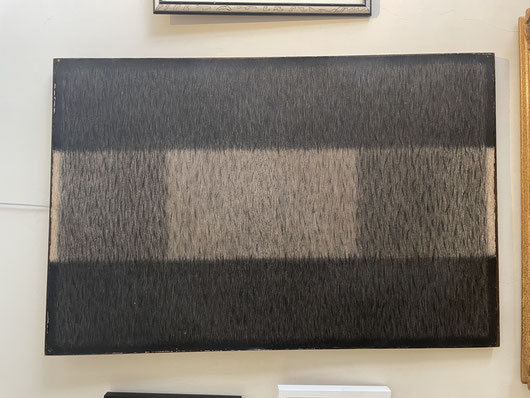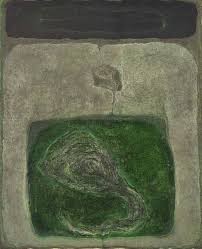Satish PANCHAL (1935-2021)

Prix : nous consulter
Satish Panchal nait à Bombay en 1935. Très jeune, il montre une grande habileté et un intérêt pour l’art. Il obtient son diplôme à la J.J. School of Art, et devient responsable de la communication visuelle de la Galerie Chemould où il se lie d’amitié avec les artistes, ses ainés : Gaitonde, Ambadas, Homi Patel, et ses contemporains : Barwe, Navjot, Altaf, Darshan.
Bombay est une métropole active, centre des affaires et siège de la plus importante industrie mondiale du cinéma, « Bollywood ». Différents centres culturels étrangers proposent au public leurs actualités artistiques : revues, catalogues, ciné-clubs, conférences… Les jeunes artistes sont curieux d’aller à la rencontre d’autres pratiques, de se mesurer à de nouveaux défis.
Installé à Paris au début des années 70, Satish Panchal rejoint quotidiennement son atelier du Bateau-Lavoir où il travaille la journée durant au son des ragas, musique classique indienne à laquelle il reste fidèle toute sa vie, indispensable à son inspiration. C’est un artiste tour à tour silencieux, enjoué, réfléchi, affable.
Panchal choisit très tôt la voie de l’abstraction, après des débuts brièvement figuratifs. La peinture à l’huile et la gravure sur bois sont les mediums qu’il privilégie. Il observe les oeuvres de Joseph Sima, Ad Reinhardt, Robert Ryman… des oeuvres qui sont autant de défis à l’image. Ainsi, l’abstraction de Panchal n’a pas recours aux archétypes pop de la culture indienne, ni aux formes du tantrisme ou à d’autres totems.
Ses tableaux déploient des compositions lumineuses et colorées où l’espace, porteur de formes en suspens, s’anime d’autres espaces aux consistances subtiles. Par des gestes attentifs, la peinture déposée par touches successives à la surface de la toile permet de donner à celle-ci une épaisseur, une forme de vibration. Les tableaux confèrent ainsi une profondeur à un jeu de surfaces traversées de lignes, d’échappées, où les espaces malgré leur partition semblent cohabiter dans une abstraction apaisée. L’artiste souhaitait selon ses mots « déranger l’espace, pour ne pas le déranger ».
Ses souvenirs d’enfance, son profond attachement aux couleurs, senteurs, saveurs et harmonies de la mère-patrie ont soutenu son long exil – cinquante ans de vie à l’occidentale – avant de s’éteindre au coeur de sa famille, sur la côte bretonne la veille de ses 86 ans.

Painter, engraver and silk-screen printer-
Satish Panchal spoke about his development as an artist, and recounted his early life in Mumbai in the 1940s. He said: "The
advantage of studying in a big city like Mumbai was that the students could get hold of foreign art magazines through the British Library, the USIS or the Alliance Francaise, and could meet
fellow young artists at Bharatiya Vidya Bhawan and the Bhulabhai Art Institute where Indian classical music concerts and dance programs were preformed."
A few artists worked in the studios of the Bhulabhai Arts Center where he first met Homi Patel and Gaitonde, both abstract painters, particularly inspiring as far as monochromy and research on
space was concerned. He liked the meditative aspect of their work.
Satish Panchal was further acquainted with the works of contemporary painters, exhibiting at Gallery Chemould when working there, especially the paintings of Ambadas and Ramkumar and early
collages of Himmat Shah, and later on Nasreen Mohamedi's works. Other artist friends whose works he also admired whether abstract or figurative were Jeram Patel, Subramaniyam and contemporaries
like Prabhakar Barwe, Swaminathan, Lalitha Lajmi, Altaf and the Koltes. According to him, he has particularly been influenced by Supermatism and the Russian avant-garde, painters like Ivan Kljun,
Ksenija Ender, El Lissitzky and Malevich of course, and American painters Ad Reinhardt and lately Robert Ryman.
He took to spirituality in the sixties, and attended several lectures of J Krishnamurthy and Acharya Rajneesh, whose teachings influenced him greatly as an individual and as an artist. The
latter, especially had analyzed the approach of modern art in particular of abstraction in connection with the contemplation.
To begin with, he painted a series of oil paintings mixed with sand on canvas. The series titled 'Horses' was first exhibited at Gallery Chemould in the year 1964, and was extremely well
received. The 'Horses' served as a pretext to create and compose space. After his third one-man show on the same theme, he decided to eliminate them because he did not want to be tagged as only
doing 'horses', and was wary of getting stereotyped.
He was always attracted to non-representative art. As stated above, when he started, he improvised on 'horses'. They were sort of representative work - more graphic in nature. Then he slowly he
veered towards minimal art. He was already acquainted with the works of American painters like Rothko, De Kooning, Sam Francis and Barnett Newman who inspired him particularly in their approach
towards space and color. In 1970, just before his marriage, and just before leaving for Europe, he participated in a joint show with his three artists friends, namely Ambadas, Darshan and Altaf.
Later, he settled in France.
There he came across the works of French artist Sima and Belgian painter Henri Michaux. He was also very much impressed by Malevich's retrospective show. Soon, he started visiting the art
galleries and museums in Europe to study the trends in contemporary art. In the 1980s, he painted a series of monochromes, which he exhibited in a solo show at Basel International Art fair in
1982. In 1978, the French Ministry of Culture attributed a studio to him in Bateau-Lavoir, after they had bought his works in various salons. It's an historical place where Cubism was
born.
As the artists explains: "Over a period of time, I discovered the very silence the paintings exuded. Space formed the crux of my work. I always cared to create space." Rendering that space with
geometrical forms was his challenge as an artist, and moving into abstractions was a natural progression. The textural value of his paintings, collages, or engravings is noteworthy. The artist is
also inspired by the Indian classical music, as he visualizes his forms - irrespective of the media he works on.
POUR TOUTES INFORMATOINS , veuillez nous contacter

